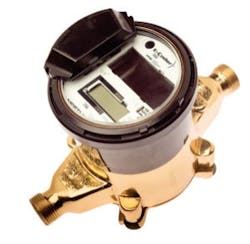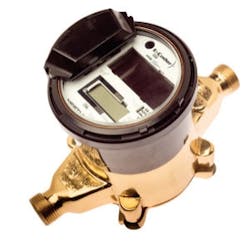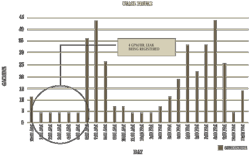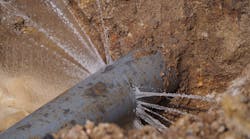In the world at large, most would agree that there are different kinds of "smarts" – book-smarts, street-smarts, social intelligence, musical intelligence, and so on. Within the utility industry, you've probably heard of the "smart grid." But when it comes down to water utilities, "smart" means "able" to solve their problems.
Many think that having an advanced metering infrastructure (AMI) system automatically makes it a smart system. Not necessarily. There's base-level AMI and there's smart AMI. And, for that matter, there is base-level AMR (automatic meter reading) and smart AMR.
What makes the difference? It's not so much in the host software or even in the method of data collection. It's in the data generated itself. A system's intelligence is measured where the flow is measured – all the way back at the endpoint where the encoder register meets the meter.
So then, what makes a smart encoder so smart? First, it should be a solid-state absolute encoder with 8-digit, high-resolution registration. Whereas a standard 6-wheel encoder gives 10-gallon registration, an 8-digit encoder provides registration all the way down to a tenth of a gallon. This way, the encoder is able to flag smaller leaks early before they have a chance to become a problem. That extra resolution can allow an 8-digit encoder to detect a leak that a 6-digit encoder would miss entirely.
Some systems also offer the ability to monitor flows in 15-minute intervals. Again, this is information generated inside the encoder register, not extrapolated up the line within the radio endpoint or host software. Monitoring in 15-minute intervals allows utilities to accurately detect not only leaks but reverse flow events as well. It can also assist them with correct meter sizing.
AMR Products
Both Neptune's ARB® Mobile™ and ARB® FixedBase™ AMR Systems build upon smart AMR. The company will display the systems at ACE'10 in Chicago. The E-Coder® Solid State Absolute Encoder provides 8-digit resolution and 15-minute-interval monitoring and also sets flags within the register's application-specific integrated circuit (ASIC) whenever a leak, tamper, or reverse flow event occurs.
Suppose there were flags for each interval, four times an hour, all day long? The utility would have a positive identification of a continuous leak state. Flags that appeared "off and on" would indicate an intermittent leak. For those utilities using ARB Mobile, each truck roll would yield the latest leak information from each meter along its route.
The E-Coder)R900i ™, which combines the E-Coder with a radio frequency (RF) meter interface unit (MIU), takes the smart encoder concept a step farther by providing a rolling 96-day period of hourly historical consumption data which can be manually extracted by personnel at the endpoint. This data logging can provide a detailed pattern of exactly when and how much water is used by a particular customer – and even pinpoint the precise duration of a leak. This is especially helpful in resolving customers' inquiries about high water bills.
Utilities using the ARB FixedBase AMR, one-way fixed network system, and its R900 Gateway can capture even more frequent updates of this data, as readings are updated every 15 minutes for those meters within range of the gateway. The gateway also provides leak, tamper, and reverse flow alerts from the flagged intervals across the network each day, allowing more proactive customer service.
AMI Ability
The data provided by Neptune's E-Coder can also drive advanced metering infrastructure – the ARB® FixedBase™ AMI two-way system based on R450™ technology. The same flow monitoring at 15-minute intervals, as well as the same leak, tamper, and reverse flow flags, can be used to produce priority alarms for an entire system of R450 MIUs or for a selected population. Whenever predetermined flow parameters are met, the MIU overrides its normal transmission schedule to send the encoder's alarm information. The ARB N_SIGHT AMI host software allows configuration for alerting selected personnel immediately so that they can take action.
In the course of a follow-up call, based either on a priority alarm or a high bill complaint, maintenance personnel can go to the encoder on site and see the current flow-rate information. If there's positive accumulation, they have the information to take any necessary action, or at least have proof of consumption for the customer. Of course, proof of consumption is also available through usage profile graphs that can be generated in AMI host software. The relevant data for the account, the amount used, and the exact times, are all detailed and can be printed out or emailed to customers.
Going Forward
Whether used as part of a mobile system or as a part of either a one-way or two-way fixed network system, a smart encoder provides the kind of advanced data that benefit utilities and their customers. In terms of water conservation, leak detection down to a tenth of a gallon helps utilities to save their water supply. And through more proactive notification of leaks, utilities make it possible for customers to correct problems that would otherwise lead to higher water bills.
Likewise, through customer usage profiling, utilities can identify where and when water is used, helping to enforce initiatives such as water restrictions. When customers are shown how off-cycle usage affects their water bill, they can take measures to adjust and better monitor their own usage – and even compare their consumption to average use in their area.
Another operational benefit to utilities is the E-Coder's identification of reverse flow events that may indicate a potential contamination of the water supply.
Installing a smart encoder offers the option of additional functionality, whether or not utilities take advantage of the technology right away. Those options may include implementing new initiatives such as time-of-use pricing that places a premium on water used during peak periods or drought conditions. It may mean adding other, complementary smart components such as acoustic leak loggers that monitor distribution mains. And it may mean migrating from mobile AMR to fixed network data collectors and host software that fully optimize the value of the system.
More WaterWorld Current Issue Articles
More WaterWorld Archives Issue Articles





